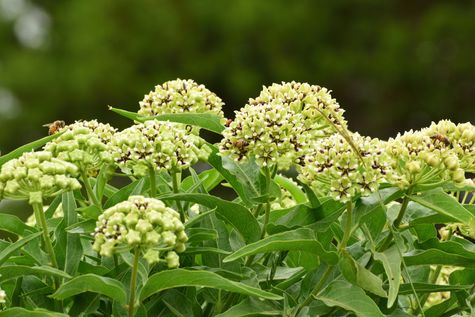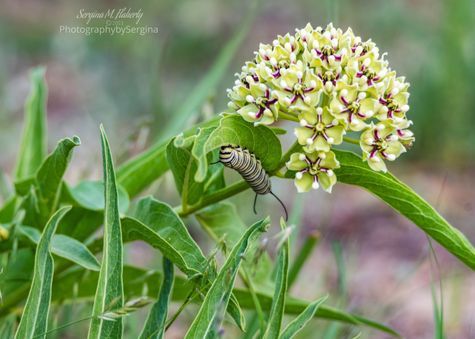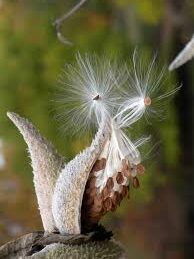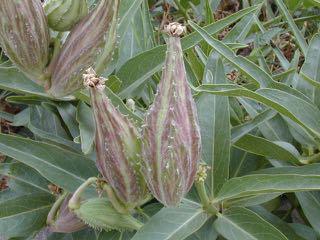Antelope Horn Milkweed
by CMG Betty J

Texas Milkweed Feast by Michael Davis
According to www.MonarchWatch.org, there are more than 200 species of milkweed. About 110 of them live in North America, and several species are native to central Texas. In the Hill Country the most common milkweed is Ascelpias asperula, antelope horn milkweed. It usually grows in rocky soil with oak trees, ashe junipers, mesquite and yucca and gets its common name from the seed pods, called follicles, that form from pollinated flowers; they resemble antelope horns. Antelope horns are also called green-flowered and spider antelope horn milkweed. This low-growing perennial (one to three feet) is one of the milkweed hosts for Monarch butterflies.

Monarch caterpillar on antelope horn milkweed by Sergina Flaherty
The flowers grow in clusters about the size of a softball. Each flower in the group has five pale green petals that cup around five prominent white hoods. These hoods store the plant’s nectar. Milkweed pollination is a complicated affair involving insects feeding on nectar and their appendages slipping in a slit in the stigma where the granular mass of pollen is stored. Since milkweed does not produce individual pollen grains, the entire pollen mass, the pollinarium, sticks to its appendage when it is pulled from the stigmatic slit. The pollinarium is deposited on another flower as the insect feeds.
Most milkweeds are toxic to vertebrate herbivores. When Monarch larvae eat milkweed foliage, they also ingest the plant’s toxins. The toxic compounds gather in their wings and exoskeletons, making both the larvae and adults poisonous to many predators. The predators may have evolved to avoid Monarchs because they learn that the larvae and adults taste bad and/or make them vomit. Despite this toxicity, Native Americans learned to use the plants for treatment for congestion, fever, and headaches, as well as a contraceptive. This same toxicity makes it a danger to grazing livestock; however, after a killing frost it is no longer toxic.

 Loss of natural milkweed habitat is greatly diminishing the availability of these plants to provide a nursery setting for Monarch butterflies. The good news is that these plants are easy to grow, have a variety of pleasing characteristics, and are readily available to plant in a native landscape. Milkweed has a large tap root and so grows most successfully if it does not have to be transplanted. If there are native plants in the vicinity, seeds can be harvested by placing a band around the seed pods as they begin to grow large. The seeds will mature inside the follicle, but the pod will not be able to burst open to disperse the seeds. They can then be collected to be planted. This is especially easy with antelope horn milkweed because of the shape of the follicles.
Loss of natural milkweed habitat is greatly diminishing the availability of these plants to provide a nursery setting for Monarch butterflies. The good news is that these plants are easy to grow, have a variety of pleasing characteristics, and are readily available to plant in a native landscape. Milkweed has a large tap root and so grows most successfully if it does not have to be transplanted. If there are native plants in the vicinity, seeds can be harvested by placing a band around the seed pods as they begin to grow large. The seeds will mature inside the follicle, but the pod will not be able to burst open to disperse the seeds. They can then be collected to be planted. This is especially easy with antelope horn milkweed because of the shape of the follicles.